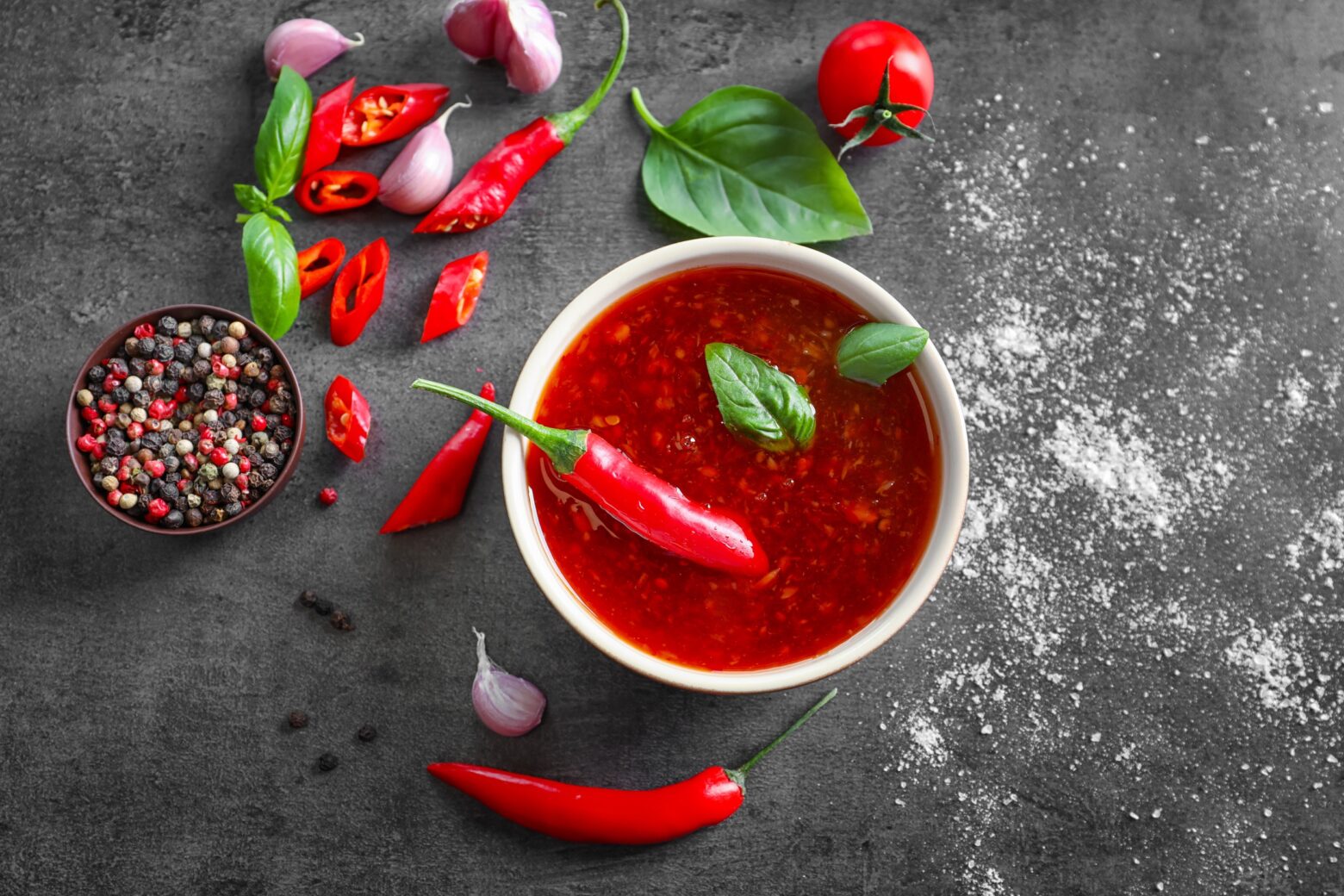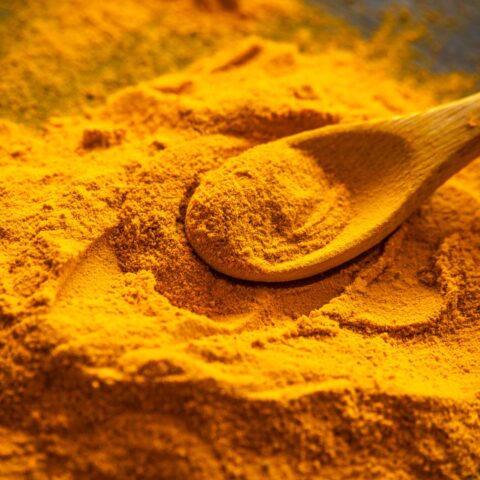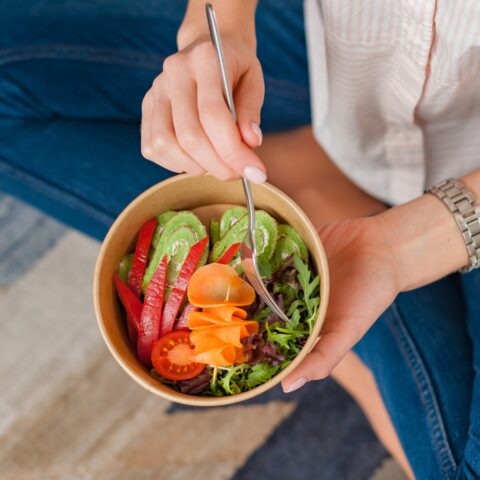Fiery Hot Sauces: Are They Healthy?

Almost all of us are familiar with hot sauces—who among us hasn’t encountered a bottle of Tabasco, Cholula, Crystal, Tapatío, or Sriracha hot sauces at our favorite restaurant?
Later, I will get into the specific formulations of popular hot sauces, but for now, let it be known that most are mixtures of hot chili peppers, salt, and vinegar, among other ingredients.
A Brief History of Chili Peppers
Obviously, the most important component of fiery hot sauces is their chili peppers. All worldwide farmed chili peppers were first grown from wild seeds indigenous to present-day Mexico and dated to about 7,000 to 8,500 years before present (B.P.). [1-4] These chili pepper plants were eventually domesticated by about 900 BC. [2]
Consequently, chili peppers represent a very recent dietary addition for our genus (Homo), which originated at least 2 million years ago in Africa. Clearly, numerous North and South American plant foods also represent unique dietary additions for humans as we migrated from Asia to the western hemisphere. So, at least upon initial glance, chili peppers characterize just one of hundreds of novel plant foods that humans encountered as our species made our way into North and South America about 15,000 years B.P.
Nevertheless, chili peppers are nutritionally unique because they are the only plant species in the world that produce capsaicinoids. [5, 6] Capsaicinoids are the molecular compounds that give chili peppers their pungent taste and burning sensation when consumed—the higher the capsaicinoids concentration, the greater we perceive the feeling of “heat.”
Why Are Chili Peppers So Hot?
Two major biochemical forms of capsaicinoids exist: capsaicin (trans-8-methyl-N-vanillyl-6-nonenamide) and dihydrocapsaicin (8-methyl-N-vanillynonanamide) which represent about 77-98 percent of the capsaicinoids present in chili peppers. [7] Other minor capsaicinoids within chili peppers include nordihydrocapsaicin, homocapsaicin, homodihydrocapsaicin and nonivamide among more than 20 similar compounds. [7]
All five domesticated species of chili peppers (Capsicum annuum, Capsicum frutenscens, Capsicum chinense, Capsicum pubescens and Capsicum baccatum) originated in the Americas. [1-4] On the 15th of January, 1493, during Columbus’ first voyage back to Spain from the new world, he recorded in his diary that large quantities of chili peppers (which he called “axi, ques su piiento”) were harvested on Hispaniola (now the islands of Haiti and the Dominican Republic) by the native Americans. [2] Shortly after his return to Spain from Hispaniola (on the 3rd of April, 1493), Columbus presented chili peppers to King Ferdinand and Queen Isabella of Spain who commented that “axi” burned their tongues. [2]
Diego Alvarez Chanca, a physician on Columbus’ second voyage to the West Indies in 1493-1496 also brought chili peppers back to Spain. [8] In the ensuing 200 years, hot chili peppers then rapidly made their way to India, East Asia, and Southeast Asia [2] where they have become integral parts of the cuisines of these regions.
Although only five species of domesticated chili peppers are commonly consumed, numerous cultivars of these species are frequently eaten, and each cultivar maintains widely varying concentrations of capsaicinoids. The “heat” or relative pungency of any species or cultivars of chili peppers is measured by the concentration of capsaicinoids which it contains. These concentrations are most accurately determined by high performance liquid chromatography (HPLC) procedures (9), but most frequently are measured using Scoville Heat Units (SHU), a subjective human measurement of “heat” or spiciness. [9]
For instance, the cultivar we all know as “green bell peppers” are a member of Capsicum annuum and maintain a Scoville Heat Unit of 0-100, meaning that this pepper has little or no perception of spiciness or “heat”. [10-39] On the other hand, jalapeno peppers which also belong to the same species, Capsicum annuum, are considerably hotter than green bell peppers and have SHU ratings between 2,500 to 8,000. [10-39]
The hottest of all peppers belong to the species, Capsicum chinense (the cultivars of this species are also known as ghost, habanero, datil, Scotch bonnet, naga, fatalli and bhut jolokia among other peppers) and maintain SHU rating between 272,897 and 1,037,305. [10-39] Intermediate to Capsicum annuum and Capsicum chinense chilies are members of the pepper species, Capsicum frutescens, which includes Tabasco, Thai, Piri Piri, Malagueta and Malawian Kambuzi peppers with SHU values ranging from 109,508 to 487,619 (10-39).
The race to produce a “hotter” hot sauce with the highest SHU rating of course makes for an interesting story on the internet, social media, and daily newspapers. [40] As hotter hot sauces burn your tongue and make you sweat, few of us consider the health implications of regular capsaicinoid ingestion.
The Best Hot Sauces Are Low in Sodium
Table 1 below shows the sodium content, the Scoville Heat Units, the caloric density, the price and type of peppers found in 33 widely available hot sauces. Note that several hot sauces are manufactured without any added salt, and many brands contain very little sodium (< 35 mg/tsp) including the bestselling McIIhenny’s Tabasco (Original Red) Sauce. Because most hot sauces primarily contain salt, water, vinegar and chili peppers; they are uniformly low in calories (0-10 kcal per teaspoon; Table 1).
Accordingly, these two nutritional characteristics (low sodium, low calories) can be viewed as “Good” from a health perspective. The USDA recommended sodium intake is 2,300 mg per day for adults and 1,500 mg per day for people with high blood pressure. Hence, a few hot sauces commonly available at grocery stores (Cholula, Tapatio, Crystal, Franks Red Hot Original and Louisiana Hot Sauce) represent condiments with higher concentrations of salt and therefore should be consumed cautiously for people wanting to reduce their sodium intake.
Table 1. The sodium (Na+) content, Scoville Heat Units, energy (kcal), price and type of chili peppers in 33 brands of hot sauces (10-39).

Hot Sauces Are Fermented—and That Might Be a Good Thing
Many people are unaware that most hot chili pepper sauces are fermented foods. For instance, one of the original hot sauces, McIllhenny’s Tabasco Sauce (Original Red) is produced by grinding fresh peppers into a mash and then soaking the mash in a salt solution inside covered white oak barrels for up to three years. [41] The mash is then strained of skins and seeds and mixed with vinegar for a month to produce the final sauce. [41]
This process (soaking in salt and then vinegar under anerobic [without oxygen] conditions) promotes growth of anaerobic bacteria which allow the food (mashed chili peppers) to ferment but not to spoil and putrefy. Salt encourages the growth of halophilic (salt loving) anaerobic bacteria. Vinegar increases the environmental acidity (lowering the pH) of the mixture which also boosts anaerobic, fermentive, bacterial growth.
Accordingly, the use of salt, vinegar, and covered containers epitomizes a universal and traditional formula to ferment food, thereby preventing its spoilage. [42] Hence, fermented plant food contained within covered containers along with salt and vinegar produces a powerful anti-pathogenic effect causing the rapid disappearance of putrefying and disease producing bacteria in the fermented concoction including: Staphylococcus aureus; Salmonella typhymurium; Listeria monocytogenes; Escherichia coli; Clostridium perfringens and Vibrio parahaemolyticus (42, 43).
The anaerobic bacteria and other microorganisms causing the fermentation of vegetables including chili peppers produce metabolic byproducts which are released into the fermented vegetable mixture. Bacteria which ferment plant foods including sauerkraut (fermented cabbage,) pickles (fermented cucumbers,) kimchi (all Korean fermented plant food including cabbage, radishes, cucumbers, chili peppers, mustard leaves, and Welsh onion leaves) [42] encourage further growth of anaerobic bacteria. [42, 44]
Olives also are fruits produced by their fermentation in salt and vinegar. A less appreciated fermented food is chocolate (the fermented fruit of Theobroma cacao; the South American chocolate tree) which does not require either salt or vinegar for its fermentation.
Many fermented foods contain similar anaerobic bacteria and microorganisms, hence the fermented foods we regularly consume (cheeses, salami, sauerkraut, pickles, olives, kimchi, chili peppers, and chocolate) maintain similar bacterial nutrients derived from the microorganisms and bacteria responsible for their fermentation.
The bacterial compounds infused into fermented foods have seldom been recognized as therapeutic nutritional agents. In part, because nutritionists have not specifically measured these bacterially produced nutrients in fermented foods. For instance, pork has only recently (2016) been demonstrated to be a rich source of short (MK-4) and long chain menaquinones (MK-9 to MK-11) or vitamin K2. [45] Long-chain menaquinones can only enter the human food chain through bacterial contamination (spoilage/fermentation) of the normal fresh food which we eat.
Swine are notorious consumers of rotten, putrid and fermented food. [46] Hence it is not surprising that pig tissues should represent a concentrated source of the bacterial nutrients which they consume such as the fat-soluble menaquinones (MK4, MK-9 to MK-11) or vitamin K2. Specifically, long-chain bacterially derived menaquinones are concentrated in the fat tissues of swine. [45] A long-term evolutionary function of menaquinones (vitamin K2) is to act as lipid soluble antioxidants for anaerobic bacterial species. [47-49]
A wide range of bacterial species have been found with the spontaneous fermentation of Jalapeno chili peppers in a saline environment including the anaerobic lactic acid bacteria (LAB) Lactobacillus plantarum, Leuconostoc citreum, Weissella cibaria and Lactobacillus paraplantarum. [50] Further, these same genera (Leuconostoc, Lactobacillus, Weissella) and others Lactococcus and Pediococcus are key players in kimchi fermentation. [51]
The crucial point here is not to become overly engaged in the microbiology of specific bacterial species which cause fermentation of chili peppers and other vegetables and fruits, but to realize that common bacterial species are associated with the fermentation of almost all plant foods. These common anaerobic LAB bacterial species, during the fermentation process, synthesize nutrients which have the capacity to serve as lipid soluble antioxidants capable of defusing the toxic ROS produced by the mitochondria in aerobic cells.
Currently, the menaquinone concentrations in bacterial species of LAB are either unknown or obscure; further these lipid soluble antioxidants have rarely or never been measured in fermented chili peppers or other fermented foods except soybeans. Other bacterially produced, important lipid soluble antioxidants which have been shown to improve health such as melatonin [52], pyrroloquinoline quinone (PQQ) [53] and CoQ10 [54] and CoQ9 have not or have barely been measured in fermented foods such as spicy hot sauces, despite the knowledge that fermented peppers and fermented vegetables may contain bacterial species capable of producing these lipid soluble antioxidant compounds.
Numerous studies have suggested that capsaicinoid containing foods may have positive and therapeutic health promoting effects. [55-65] In humans, the biological receptor for capsaicin is called the transient receptor potential vanilloid subtype 1 (TRPV1) which is widely expressed in brain, sensory nerves, bladder, gut and blood vessels. TRPV1 is activated by multiple environmental stimuli including exogenous chili pepper capsaicin ingestion, heat, low pH (<5.9) and certain endogenous lipid molecules. [63] TRPV1 plays essential roles in inflammation, oxidative stress, and pain sensation. [66] Accordingly, capsaicinoids derived from the consumption of hot chili peppers and fiery hot sauces likely have therapeutic functions in the prevention of cardiovascular disease [62-64], diabetes [62, 64], pain [62, 66] and certain autoimmune diseases. [65]
Nevertheless, an infrequently recognized downside to consumption of chili peppers is their ability to disrupt the intestinal barrier function. [67-78]
Some Hot Sauces Could Be Bad for Gut Health
Exogenous dietary capsaicinoids from chili peppers represent unique biochemical compounds which the human genome did not encounter until very recently from an evolutionary perspective. As previously demonstrated, Columbus and his crew brought chili peppers to Europe in 1493, and they then spread worldwide in the ensuing 200 years. Accordingly, our species has had little or no time to evolve genetic adaptations to an exogenous plant substance (capsaicinoids) which fundamentally interact with our physiologies via the TRPV1 receptor and other cellular mechanisms.
One of the unexpected health consequences of worldwide chili pepper consumption is its adverse effect upon the human gut, particularly with chili pepper species and cultivars which maintain higher capsaicinoid concentrations and hence higher SHU values.
The notion that chili pepper consumption could increase intestinal permeability was unknown until 1994 when Hashimoto and colleagues [67] demonstrated that a vegetable extract only found in sweet peppers (of 32 vegetables analyzed) impaired the intercellular tight junction (TJ) barrier through the paracellular pathway. The authors noted that these changes would, “bring about an invasion of allergenic molecules from the intestinal lumen to the serosal region, which may cause food allergy.”
In their 1997 follow-up study [68], Hashimoto and co-workers identified that the active substances in the purified sweet pepper extract which increased intestinal permeability were capsianosides (capsaicins). The authors suggested that, “capsianosides would be useful to enhance the permeability for drugs or other biologically important hydrophilic substances across the intestinal mucosa.”
One year later in 1998 Jensen-Jarolim and colleagues [69] demonstrated that paprika and cayenne pepper spices increased intestinal macromolecular permeability. The authors noted that this event might be of pathophysiological importance, particularly with respect to food allergy and intolerance.
One mechanism underlying capsaicin’s ability to increases intestinal permeability was further examined by Isoda, Han, and colleagues in a series of papers. [69-71] These investigators demonstrated that capsaicin’s intestinal permeability impairment resulted partially from capsaicin’s ability to bind the TRPV1 receptor in the gut which directly altered tight junction opening characteristics partially via increasing calcium influx in intestinal cells. [70, 71]
One of the implications about capsaicin ingestion from chili peppers is this compound’s ability to promote drug [71], macromolecule and intestinal luminal content (allergens) movement across the intestinal barrier. [67-69] A molecule of potential interest from capsaicin’s increase in gut permeability is LPS, a pro-inflammatory residue from gut bacteria. Current studies suggest that capsaicin induces an anti-inflammatory profile that inhibits LPS-induced IL-1β, IL-6 and TNF-α production in a time- and dose-dependent manner [79] that sensitizes the TRPV1 receptor activation. [80]
Given this information and the prior data suggesting that capsaicin does not promote autoimmune disease [65], which clearly has an increased gut permeability element, it appears that capsaicin’s ability to increase gut permeability may not be associated with increased inflammation [79] or autoimmunity. [65]
An important caveat to the autoimmune data associated with capsaicin consumption is a recent study suggesting that hot chili pepper consumption may cause the cellular events leading to disease symptoms in IgA nephropathy patients. [81]
The Bottom Line
Regular consumption of hot chili peppers may have numerous health-promoting effects, and its pungent taste adds to the cuisine of worldwide cultures.
Fiery hot sauces are low in calories, frequently (but not always) low in sodium and often contain mashes of chili peppers with bacterially fermented by-products and their residues that may have therapeutic health effects together with the beneficial effects of the capsaicinoids present in chili themselves.
People trying to lower their sodium intake can choose fiery pepper sauces with lower salt formulations. People with food allergies and certain autoimmune diseases may benefit by limiting pepper sauce consumption or ingesting sauces and chili peppers with lower capsaicin concentrations.
References
1. Kraft KH, Brown CH, Nabhan GP, Luedeling E, Luna Ruiz Jde J, Coppens d’Eeckenbrugge G, Hijmans RJ, Gepts P. Multiple lines of evidence for the origin of domesticated chili pepper, Capsicum annuum, in Mexico. Proc Natl Acad Sci U S A. 2014 Apr 29;111(17):6165-70.
2. Halikowski Smith S. In the shadow of a pepper-centric historiography: Understanding the global diffusion of capsicums in the sixteenth and seventeenth centuries. J Ethnopharmacol. 2015 Jun 5; 167:64-77
3. Perry L, Dickau R, Zarrillo S et al. Starch fossils and the domestication and dispersal of chili peppers (Capsicum spp. L.) in the Americas. Science. 2007 Feb 16;315(5814):986-8.
4. Perry L, Flannery KV. Precolumbian use of chili peppers in the Valley of Oaxaca, Mexico. Proc Natl Acad Sci U S A. 2007 Jul 17;104(29):11905-9
5. Arce-Rodríguez ML, Ochoa-Alejo N. Biochemistry and molecular biology of capsaicinoid biosynthesis: recent advances and perspectives. Plant Cell Rep. 2019 Apr 2. doi: 10.1007/s00299-019-02406-0.
6. Popelka P, Jevinová P, Šmejkal K, Roba P. Determination of capsaicin content and pungency level of different fresh and dried chilli peppers, Folia Veterinaria. 2017 61(2): 11-16.
7. Barbero GF, Ruiz AG, Liazid A, Palma M, Vera JC, Barroso CG. Evolution of total and individual capsaicinoids in peppers during ripening of the Cayenne pepper plant (Capsicum annuum L.) Food Chem. 2014 Jun 15; 153:200-6.
8. Bosland PW, Votava EJ. Peppers: Vegetable and Spice Capsicums. New York: Cabi, 2000.
9. Kachoosangi RT, Wildgoose GG, Compton RG. Carbon nanotube-based electrochemical sensors for quantifying the ‘heat’ of chilli peppers: the adsorptive stripping voltammetric determination of capsaicin. Analyst. 2008 Jul;133(7):888-95
10. http://www.scottrobertsweb.com/scoville-scale/
11. Othman ZA, Ahmed YB, Habila MA, Ghafar AA. Determination of capsaicin and dihydrocapsaicin in Capsicum fruit samples using high performance liquid chromatography. Molecules. 2011 Oct 24;16(10):8919-29
12. Ananthan R, Subhash K, Longvah T. Capsaicinoids, amino acid and fatty acid profiles in different fruit components of the world hottest Naga king chilli (Capsicum chinense Jacq). Food Chem. 2018 Jan 1;238:51-57.
13. Antonious GF, Jarret RL. Screening Capsicum accessions for capsaicinoids content. Journal of Environmental Science and Health Part B. 2006 Aug 1;41(5):717-29.
14. Canto-Flick A, Balam-Uc E, Bello-Bello JJ, Lecona-Guzmán C, Solís-Marroquín D, Avilés-Viñas S, Gómez-Uc E, López-Puc G, Santana-Buzzy N, Iglesias-Andreu LG. Capsaicinoids content in habanero pepper (Capsicum chinense Jacq.): hottest known cultivars. HortScience. 2008 Aug 1;43(5):1344-9.
15. Cisneros-Pineda O, Torres-Tapia LW, Gutiérrez-Pacheco LC, Contreras-Martín F, González-Estrada T, Peraza-Sánchez SR. Capsaicinoids quantification in chili peppers cultivated in the state of Yucatan, Mexico. Food Chemistry. 2007 Jan 1;104(4):1755-60.
16. Deng M, Wen J, Zhu H, Zou X. The hottest pepper variety in China. Genetic resources and crop evolution. 2009 Aug 1;56(5):605-8.
17. Dong MW. Instruments & Applications How Hot Is That Pepper? Quantifying capsaicinoids with chromatography. Today’s Chemist at Work. 2000;9(5):17-22.
18. Duelund L, Mouritsen OG. Contents of capsaicinoids in chillies grown in Denmark. Food Chem. 2017 Apr 15; 221:913-918.
19. Dyah JS, Oen LH, Winarno FG. Capsaicin content of various varieties of Indonesian chilies. Asia Pacific J Clin Nutr 1997;6: 99-101.
20. Gahungu A, Ruganintwali E, Karangwa E, Zhang X, Mukunzi D. Volatile compounds and capsaicinoid content of fresh hot peppers (Capsicum chinense) scotch bonnet variety at red stage. Adv. J. Food Sci. Technol. 2011 Jun 6;3(3):211-8.
21. Giuffrida D, Dugo P, Torre G, Bignardi C, Cavazza A, Corradini C, Dugo G. Characterization of 12 Capsicum varieties by evaluation of their carotenoid profile and pungency determination. Food Chemistry. 2013 Oct 15;140(4):794-802.
22. Gnayfeed MH, Daood HG, Biacs PA, Alcaraz CF. Content of bioactive compounds in pungent spice red pepper (paprika) as affected by ripening and genotype. Journal of the Science of Food and Agriculture. 2001 Dec;81(15):1580-5.
23. Islam MA, Sharma SS, Sinha P, Negi MS, Neog B, Tripathi SB. Variability in capsaicinoid content in different landraces of Capsicum cultivated in north-eastern India. Sci Hort 183 (2015) 66-71.
24. Korkutata NF, Kavaz A. A comparative study of ascorbic acid and capsaicinoid contents in red hot peppers (Capsicum annum L.) grown in southeastern Anatolia region. International journal of food properties. 2015 Apr 3;18(4):725-34.
25. Lang Y, Kisaka H, Sugiyama R, Nomura K, Morita A, Watanabe T, Tanaka Y, Yazawa S, Miwa T. Functional loss of pAMT results in biosynthesis of capsinoids, capsaicinoid analogs, in Capsicum annuum cv. CH‐19 Sweet. The Plant Journal. 2009 Sep;59(6):953-61.
26. Mathur R, Dangi RS, Dass SC, Malhotra RC. The hottest chilli variety in India. Current science. 2000;79(3):287-8.
27. Nwokem CO, Agbaji EB, Kagbu JA, Ekanem EJ. Determination of capsaicin content and pungency level of five different peppers grown in Nigeria. New York Science Journal. 2010;3(9):17-21.
28. Ogawa K, Murota K, Shimura H, Furuya M, Togawa Y, Matsumura T, Masuta C. Evidence of capsaicin synthase activity of the Pun1-encoded protein and its role as a determinant of capsaicinoid accumulation in pepper. BMC plant biology. 2015 Dec;15(1):93.
29. Perucka I, Oleszek W. Extraction and determination of capsaicinoids in fruit of hot pepper Capsicum annuum L. by spectrophotometry and high-performance liquid chromatography. Food Chemistry. 2000 Nov 1;71(2):287-91.
30. Pino J, Sauri-Duch E, Marbot R. Changes in volatile compounds of Habanero chile pepper (Capsicum chinense Jack. cv. Habanero) at two ripening stages. Food chemistry. 2006 Feb 1;94(3):394-8.
31. Popelka P, Jevinova P, Smejkal K, Roba P. Determination of capsaicin content and pungency level of different fresh and dried chilli peppers. Folia Veterinaria, 61, 2: 11-16, 2017.
32. Sanatombi K, Sharma GJ. Capsaicin content and pungency of different Capsicum spp. cultivars. Notulae Botanicae Horti Agrobotanici Cluj-Napoca. 2008;36(2):89-90.
33. Schmidt A, Fiechter G, Fritz EM, Mayer HK. Quantification of capsaicinoids in different chilies from Sustria by a novel UHPLC method. J Food Comp Analysis, 60, (2017. 32-37.
34. Sganzerla M, Coutinho JP de Melo AMT2, Godoy HT. Fast method for capsaicinoids analysis from Capsicum chinense fruits. Food Res Int. 2014 Oct; 64:718-725.
35. Sora GT, Haminiuk CW, da Silva MV, Zielinski AA, Gonçalves GA, Bracht A, Peralta RM. A comparative study of the capsaicinoid and phenolic contents and in vitro antioxidant activities of the peppers of the genus Capsicum: an application of chemometrics. Journal of food science and technology. 2015 Dec 1;52(12):8086-94.
36. Thomas BV, Schreiber AA, Weisskopf CP. Simple method for quantitation of capsaicinoids in peppers using capillary gas chromatography. Journal of Agricultural and Food Chemistry. 1998 Jul 20;46(7):2655-63.
37. Topuz A, Ozdemir F. Assessment of carotenoids, capsaicinoids and ascorbic acid composition of some selected pepper cultivars (Capsicum annuum L.) grown in Turkey. Journal of Food Composition and Analysis. 2007 Nov 1;20(7):596-602.
38. Wahyuni Y, Ballester AR, Sudarmonowati E, Bino RJ, Bovy AG. Metabolite biodiversity in pepper (Capsicum) fruits of thirty-two diverse accessions: Variation in health-related compounds and implications for breeding. Phytochemistry. 2011 Aug 1;72(11-12):1358-70.
39. Ziino M, Condurso C, Romeo V, Tripodi G, Verzera A. Volatile compounds and capsaicinoid content of fresh hot peppers (Capsicum annuum L.) of different Calabrian varieties. Journal of the Science of Food and Agriculture. 2009 Mar 30;89(5):774-80.
40. https://www.nytimes.com/2018/09/24/dining/anarchy-of-chilies-book.html
41. https://en.wikipedia.org/wiki/Tabasco_sauce
42. Rhee SJ, Lee JE, Lee CH. Importance of lactic acid bacteria in Asian fermented foods. In Microbial Cell Factories 2011 Dec (Vol. 10, No. 1, p. S5). BioMed Central.
43. Lee CH. Fermentation Technology in Korea. Korea University Press, 2001.
44. Zhang L,Xiang WL, Zeng ZS et al. Separation, identification and direct vat set (DVS) development of bacteria from fermented chili pepper. Food Sci 2013;21:242-247.
45. Fu X, Shen X, Finnan EG, Haytowitz DB, Booth SL. Measurement of multiple vitamin k forms in processed and fresh-cut pork products in the U.S. Food Supply. J Agric Food Chem. 2016 Jun 8;64(22):4531-5
46. https://www.reviewjournal.com/news/new-pig-farm-consuming-las-vegas-strips-leftovers-1535210/
47. Brooijmans R, Smit B, Santos F, van Riel J, de Vos WM, Hugenholtz J. Heme and menaquinone induced electron transport in lactic acid bacteria. Microb Cell Fact. 2009 May 29;8:28
48. Søballe B, Poole RK. Ubiquinone limits oxidative stress in Escherichia coli. Microbiology. 2000 Apr;146 (Pt 4):787-96.
49. Vido K, Diemer H, Van Dorsselaer A, Leize E, Juillard V, Gruss A, Gaudu P. Roles of thioredoxin reductase during the aerobic life of Lactococcus lactis. J Bacteriol. 2005 Jan;187(2):601-10.
50. González-Quijano GK1, Dorantes-Alvarez L, Hernández-Sánchez H, Jaramillo-Flores ME, de Jesús Perea-Flores M, Vera-Ponce de León A, Hernández-Rodríguez C. Halotolerance and survival kinetics of lactic acid bacteria isolated from jalapeño pepper (Capsicum annuum L.) fermentation. J Food Sci. 2014 Aug;79(8):M1545-53. doi: 10.1111/1750-3841.12498. Epub 2014 Jul 17.
51. Jeong SH, Lee HJ, Jung JY, Lee SH, Seo HY, Park WS, Jeon CO. Effects of red pepper powder on microbial communities and metabolites during kimchi fermentation. Int J Food Microbiol. 2013 Jan 1;160(3):252-9.
52. Reiter RJ, Rosales-Corral S, Tan DX, Jou MJ, Galano A, Xu B. Melatonin as a mitochondria-targeted antioxidant: one of evolution’s best ideas. Cell Mol Life Sci. 2017 Nov;74(21):3863-3881
53. Wu JZ, Huang JH, Khanabdali R, Kalionis B, Xia SJ, Cai WJ. Pyrroloquinoline quinone enhances the resistance to oxidative stress and extends lifespan upon DAF-16 and SKN-1 activities in C. elegans. Exp Gerontol. 2016 Jul; 80:43-50.
54. Mortensen SA, Rosenfeldt F, Kumar A, Dolliner P, Filipiak KJ5 Pella D6 Alehagen U7 Steurer G, Littarru GP; Q-SYMBIO Study Investigators. The effect of coenzyme Q10 on morbidity and mortality in chronic heart failure: results from Q-SYMBIO: a randomized double-blind trial. JACC Heart Fail. 2014 Dec;2(6):641-9.
55. Palma J.M.et al. Physiology of pepper fruit and the metabolism of antioxidants: chloroplasts, mitochondria and peroxisomes. Ann. Bot. 2015; 116: 627-636
56. Spiller F. et al. Anti-inflammatory effects of red pepper (Capsicum baccatum) on carrageenan- and antigen-induced inflammation. J. Pharm. Pharmacol. 2008; 60: 473-478
57. Bogusz S. et al. Brazilian Capsicum peppers: capsaicinoids content and antioxidant activity. J. Sci. Food Agric. 2018; 98: 217-224
58. Chapa-Oliver A., Mejía-Teniente L. Capsaicin: from plants to a cancer-suppressing agent. Molecules. 2016; 21: 931
59. Varghese S. et al. Chili pepper as a body weight-loss food. Int. J. Food Sci. Nutr. 2017; 68: 392-401
60. Hardy G. Nutraceuticals and functional foods: introduction and meaning. Nutrition. 2000; 16: 688-689
61. Anand P., Bley K. Topical capsaicin for pain management: therapeutic potential and mechanisms of action of the new high-concentration capsaicin 8% patch. Br. J. Anaesth. 2011; 107: 490-502.
62. Srinivasan K. Biological Activities of Red Pepper (Capsicum annuum) and its pungent principle capsaicin: a review. Crit Rev Food Sci Nutr. 2016 Jul 3;56(9):1488-500.
63. Sun F, Xiong S, Zhu Z. Dietary capsaicin protects cardiometabolic organs from dysfunction. Nutrients. 2016 Apr 25;8(5). pii: E174. doi: 10.3390/nu8050174
64. Kwon Y, Apostolidis E, Shetty K. Evaluation of pepper (Capsicum annuum) for management of diabetes and hypertension. Journal of Food Biochemistry. 2007 Jun;31(3):370-85.
65. Deng Y, Huang X, Wu H, Zhao M, Lu Q, Israeli E, Dahan S, Blank M, Shoenfeld Y.
Some like it hot: The emerging role of spicy food (capsaicin) in autoimmune diseases. Autoimmun Rev. 2016 May;15(5):451-6
66. Mózsik G. Capsaicin as new orally applicable gastroprotective and therapeutic drug alone or in combination with nonsteroidal anti-inflammatory drugs in healthy human subjects and in patients. In Capsaicin as a Therapeutic Molecule 2014 (pp. 209-258). Springer, Basel.
67. Hashimoto K, Matsunaga N, Shimizu M. Effect of vegetable extracts on the transepithelial permeability of the human intestinal Caco-2 cell monolayer. Bioscience, biotechnology, and biochemistry. 1994 Jan 1;58(7):1345-6.
68. Hashimoto K, Kawagishi H, Nakayama T, Shimizu M. Effect of capsianoside, a diterpene glycoside, on tight-junctional permeability. Biochimica et Biophysica Acta (BBA)-Biomembranes. 1997 Jan 31;1323(2):281-90.
69. Jensen-Jarolim E, Gajdzik L, Haberl I, Kraft D, Scheiner O, Graf J. Hot spices influence permeability of human intestinal epithelial monolayers. J Nutr. 1998 Mar;128(3):577-81.
70. Isoda H, Han J, Tominaga M, Maekawa T. Effects of capsaicin on human intestinal cell line Caco-2. Cytotechnology. 2001 Jul;36(1-3):155-61.
71. Han J, Isoda H, Maekawa T. Analysis of the mechanism of the tight-junctional permeability increase by capsaicin treatment on the intestinal Caco-2 cells. Cytotechnology. 2002 Nov;40(1-3):93-8.
72. Nagumo Y, Han J, Arimoto M, Isoda H, Tanaka T. Capsaicin induces cofilin dephosphorylation in human intestinal cells: the triggering role of cofilin in tight-junction signaling. Biochem Biophys Res Commun. 2007 Apr 6;355(2):520-5
73. Komori Y, Aiba T, Nakai C, Sugiyama R, Kawasaki H, Kurosaki Y. Capsaicin-induced increase of intestinal cefazolin absorption in rats. Drug Metab Pharmacokinet. 2007 Dec;22(6):445-9.
74. Tsukura Y, Mori M, Hirotani Y, Ikeda K, Amano F, Kato R, Ijiri Y, Tanaka K. Effects of capsaicin on cellular damage and monolayer permeability in human intestinal Caco-2 cells. Biol Pharm Bull. 2007 Oct;30(10):1982-6.
75. Nagumo Y, Han J, Bellila A, Isoda H, Tanaka T. Cofilin mediates tight-junction opening by redistributing actin and tight-junction proteins. Biochem Biophys Res Commun. 2008 Dec 19;377(3):921-5
76. Shiobara T, Usui T, Han J, Isoda H, Nagumo Y. The reversible increase in tight junction permeability induced by capsaicin is mediated via cofilin-actin cytoskeletal dynamics and decreased level of occludin. PLoS One. 2013 Nov 18;8(11):e79954. doi: 10.1371/ journal. pone.0079954
77. Duan L, Yan Y, Sun Y, Zhao B, Hu W, Li G. Contribution of TRPV1 and multidrug resistance proteins in the permeation of capsaicin across different intestinal regions. Int J Pharm. 2013 Mar 10;445(1-2):134-40
78. Prakash UN, Srinivasan K. Enhanced intestinal uptake of iron, zinc and calcium in rats fed pungent spice principles–piperine, capsaicin and ginger (Zingiber officinale). J Trace Elem Med Biol. 2013 Jul;27(3):184-90
79. Tang J, Luo K, Li Y, Chen Q, Tang D, Wang D, Xiao J. Capsaicin attenuates LPS-induced inflammatory cytokine production by upregulation of LXRα. International immunopharmacology. 2015 Sep 1;28(1):264-9.
80. Diogenes A, Ferraz CC, Akopian AA, Henry MA, Hargreaves KM. LPS sensitizes TRPV1 via activation of TLR4 in trigeminal sensory neurons. Journal of dental research. 2011 Jun;90(6):759-64.
81. Shao J, Peng Y, He L, Liu H, Chen X, Peng X. Capsaicin induces high expression of BAFF and aberrantly glycosylated IgA1 of tonsillar mononuclear cells in IgA nephropathy patients. Hum Immunol. 2014 Oct;75(10):1034-9
Loren Cordain, Ph.D.
As a professor at Colorado State University, Dr. Loren Cordain developed The Paleo Diet® through decades of research and collaboration with fellow scientists around the world.
More About The Author



